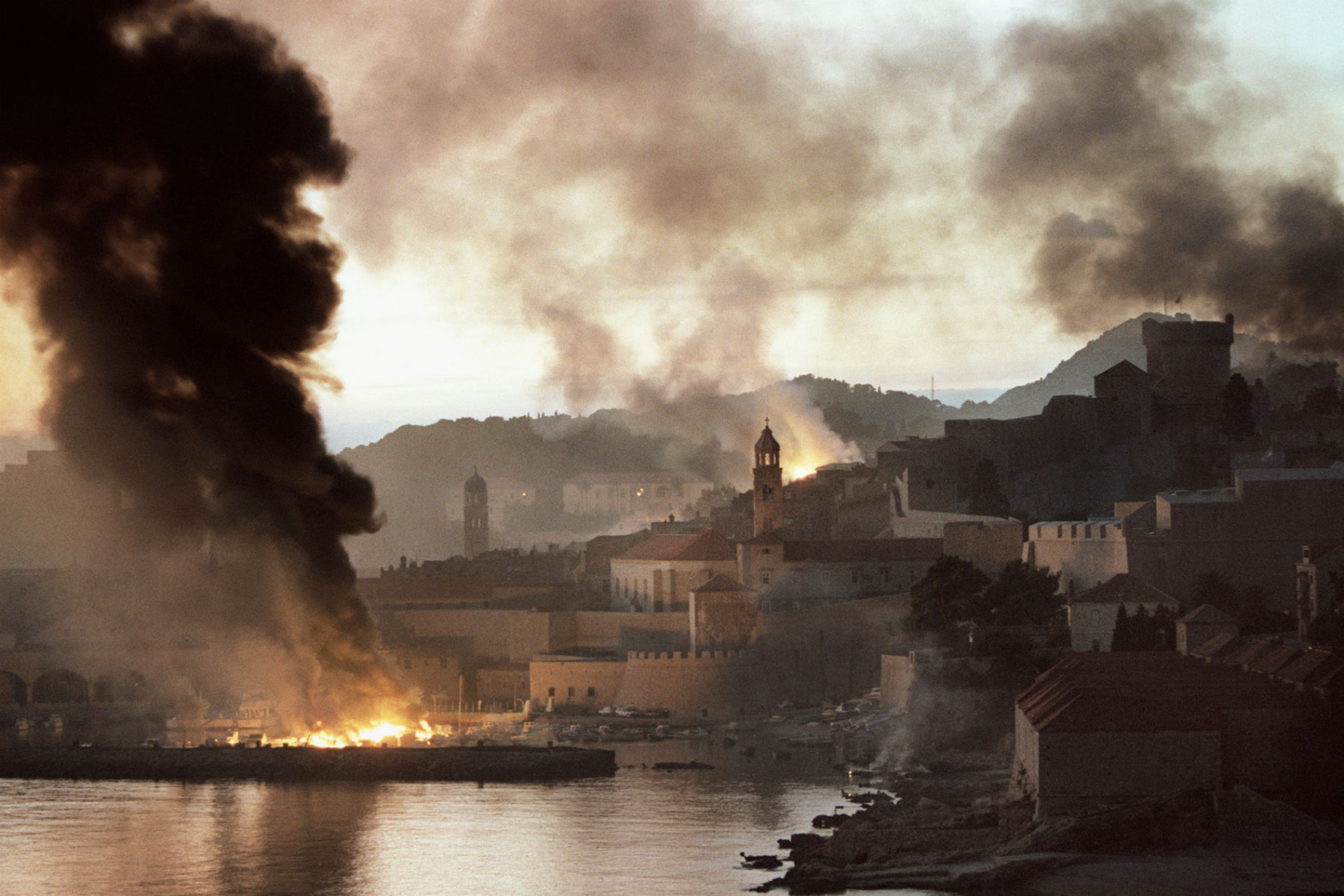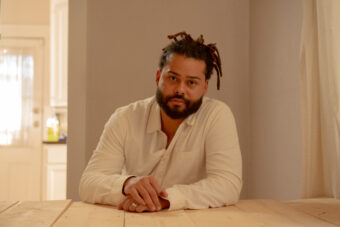This story was originally published in the May 1993 issue of SPIN. In honor of SPIN’s 30th anniversary, we’ve republished this piece as part of our ongoing “30 Years, 30 Stories” series.
[ooyala code=”llM3hmdzqUQWNUNgxQxTbRZHXf80RIt4″ player_id=”8bdb685537af477d8cd5ea1ebd611511″ width=”1920″ height=”1080″]
Martin, 21, sat in his wheelchair watching MTV. “The finest thing that man has invented!” he said. He was a fighter in the Croatian National Guard and got hit in the spine with shrapnel, paralyzing him from the waist down. After the hospital, he went straight to the Varadjin spa, and had yet to go home. Stuck in a limbo of quick edits, flashing lights, and pretty girls — and men in traction and postbattle depression —he remained optimistic. “I’ve got my whole life ahead of me,” he said. “When I leave here, I’ll try to get a job and live as normal a life as possible.” Croatia has over 700,000 refugees on its hands (the country’s population is 4.7 million), terrible inflation, and it has to keep an army up and fighting. I sat there looking at Martin, smiling, and nodding my head.
“This war was thrown at us” is what a 19-year-old girl told me when asked what I should tell the world of the plight of youth in Croatia and Bosnia-Herzegovina. She fled from Vukovar, a once picturesque baroque town, now a pile of rubble in Serb-occupied Croatia. Who threw this war at her? Greedy middle-aged men with a hunger for power. You know the old song: Remember bastards such as Erich Honecker or Nicolae Ceausescu? Pseudosocialists with large illicit bank accounts, hiding behind an ideology. It’s no different with the government of Slobodan Milosevic, the government of Serbia-Montenegro, what one newsweekly called “the rump of Yugoslavia” — in other words, what was left after the country disintegrated.

Also Read
Kurt Cobain Forever
In 1989, Stalin’s paranoid grip finally loosened and the phony regimes of the Eastern Bloc died. From Lithuania to Armenia, political boundarics were replaced with ethnic national ones. In time, the changes came down to nonaligned Yugoslavia. The fall of the Berlin wall instigated the current civil war in Yugoslavia. Milosevic, president of then-Yugoslavia, knew what the breakup of the Federation of Yugoslavian Republics would mean. Slovenia and Croatia were the most prosperous states. Before independence, 70 percent of the GNP was skimmed off to pay for the military (then the fourth largest in Europe), controlled by Miloševic in Belgrade. Breakup would also mean geographical isolation for Serbia. It would be stuck in the dark corner of Europe’s backyard with neighboring Bulgaria, Romania, Macedonia, Bosnia-Herzegowina, and Albania. (Remember Albania?) When Croatia, Slovenia, and Bosnia-Herzegovina declared independence, Milosevic came down hard.
First Serbia went to war with Slovenia, which lasted six days before Serbia wrote off the territory and pulled out to concentrate on Croatia. Serbia calls this a civil war with both sides committing equal atrocities. But Serbia not only instigated the conflict to preserve its position of power, it also inflamed the situation by resurrecting historic animosities. When Croatia declared its independence, it adopted its former national flag, which flew under the puppet government of the Nazis in World War II. Serbia played on this, terrifying its people that this meant a return to Croatian slaughter of Serbs, as happened during the Second World War.
Since the start of the war in ex-Yugoslavia, around 150,000 people have been killed, 1.5 million displaced, and about 30,000 women raped. An evil phrase has entered our vocabulary: “Ethnic cleansing” is the user-friendly way to say genocide. Mass executions, concentration camps, torture, and rape are being implemented by the Serbian government and local Serb warlords on the non-Serb population of Bosnia-Herzegovina and parts of Croatia.
In Zagreb, I hoped to make sense — if there was any — of all the sound bites, wire feeds, and editorials that I have been devouring over the past year and a half.
[featuredStoryParallax id=”161158″ thumb=”https://static.spin.com/files/2015/09/croatia-war-gracac-93-145×145.jpg”]
Both of my parents were born and raised in Croatia. I was born in Compton, California. My name, Novoselic, means newcomer and is common throughout the Balkans. Our family comes from the small island of Iz, two hours by boat from the town of Zadar. The Novoselics’ roots there trace back to the mid-1700s, even living in the same house, so I guess we’re not newcomers after all.
Things really didn’t start changing in Zadar until the late ’60s. People were poor but hearty. They farmed potatoes, figs, grapes, olives, and fished the sea. It was reminiscent of the novelist, Nikos Kazantzakis’s Greece, but with a definite Slavic-Italian vibe. As a child, I would spend summers there. I remember old women carrying baskets on their heads or standing in doorways spinning wool and gossiping. Now the gossip goes down in front of the Grundig color TV while watching the American soap opera, Santa Barbara.
I can see the changes from the old world to the new reflecting, in some way, the changes in perspective between the fond observations of a child and the brunt of reality that one must face when coming of age.
I walked through the town’s main square, stopping young people at random. I came across Elvir, 19. He was just hanging. Nothing was special about his appearance: a rock t-shirt and an S.O.D. (Stormtroopers of Death) hat, turned around. He told me that he spent most of ’92 and part of ’91 on the frontline. “It was hot, there was shooting, and I came out alive. That’s important!” he told me. “Guys who I went through that year with are no more. I was wounded, someone stepped on a mine, and some of the shrapnel hit me. I recovered.”
He then told me of the kinds of troubles 17-year-olds face when they’re fighting in combat. “There were three of us young guys. It was when the Chili Peppers and Nirvana had just come out. We would crank it up and get pumped. This would really irk the older guys.” Irk the older guys? This sounded like a situation that can happen at any car wash in the States.
The historical and contemporary images of death camps aren’t hard to conjure. In Bosnia-Herzegovina, women have special camps. Rape is part of the policy of ethnic cleansing.
He still gets shit. “When I was a soldier, I was okay. Now that I am a regular guy, I get hassled about my clothes and my hair from my elders. I come from a small village seven kilometers from the front. To the people there, the war is a fact of life; they carry their hang-ups with them.”
Zrinka, 21, mixed the heartening aspect of music with escapism. She was a nurse helping the wounded; now she studies law in Zagreb. “I am from the town of Karlovac and many bombs fell there,” she said. “My apartment is on the tenth floor and when the kitchen light was on at night we would get nervous because we knew that they [Serbians] could see us.” I asked her why they didn’t black out. “This was during the cease-fire, all of last year we fretted!” (Croatia is experiencing a shaky peace through the UN-brokered cease-fire of last year.)
During the bombardment she tended to the wounded. “I had to leave nursing, all that kept me going was my heart, my compassion for people. War is so ugly” — she spread her fingers tensely and held her hands apart, like she was holding a ball — “if you go into the wards with any sense or reason, you are finished because there is none in war.” She took advantage of the ceasefire and left.
Vesna Milac, a college professor and mother of three children in their late teens and early 20s, shares her dilemma with me. “I think they are the lost generation,” she says of her children and their peers. “They are going to inherit all of this. My eldest son’s best friend was killed near Dubrovnik and now he’s dealing with that. It is not that they don’t care, it is a facade. They are trying to live a normal life as much as possible. It is easier to go and listen to music than it is to listen to news that is frustrating, negotiations that go nowhere, and disparity all around. We parents are trying to give them a normal life, that is our instinct.”
[featuredStoryParallax id=”161175″ thumb=”https://static.spin.com/files/2015/09/croatia-civil-war-1993-145×145.jpg”]
Bosnia-Herzegovina is in a state of chaos. No cease-fire has ever held for more than a few hours. I met some young Bosnians at the Moslem center on the edge of town. The building stood alone, a white modular structure with a dome protruding on the end of it and a tall minaret adjacent. I walked up during the call to prayer, enjoying the Holy Man’s beautiful voice through the muffled sound of the loudspeakers. After prayers I looked around, not entering the mosque, staying only in the center part. It reminded me of a bustling YMCA. When I went down some stairs to a sublevel, the scene totally changed. It was crowded. People were on mats on the floor, sitting, talking, sleeping. You could see the family circles, each group had a few blankets, some clothes, and that was it. It was overwhelming. I stood there for a moment then walked out.
Outside I gathered my wits. There were two young women sitting on a planter down from me, so I approached them and said that I wrote for an American magazine that was “youth oriented.” Things were awkward at first, so I told them of the anxieties I had asking people about youth culture during such serious times. I expressed myself with a mock panic and it cracked a smile. Hadjia, 21, did all the talking, while her sister Emcija, 17, stood silent. “We had a good life before the war.” She shrugged her shoulders and shook her head asking, “And now?” What could she say? In her situation, it didn’t matter if she was 17 or 70. The tone of her voice had a labored patience about it, cracking with frustration. Her brazen eyes told me of the heavy baggage of injustice she carries around. I couldn’t miss those eyes. She was burned and had to swallow every bit of shit that was heaped on her. How many of her friends and family were killed? Had she been raped? I sure the hell wasn’t going to ask her. As if her story would make an impact on any of the other hundreds of thousands of stories from this tragedy anyway: Screw my trivial anxieties, she has been chased out of her life and sleeps on a mat in a basement. That’s the injustice that stings so intensely, the world’s lack of action turns the knife in her.
Back in 1989, my wife and I made a trip through the Krajina region of central Croatia, on our way to the coast. I noticed how much the terrain looked like Southeast California. There were low shrubs, sparse trees, rocks, and dirt. It was surprising to see a desert in Europe. Our train clanked along on rickety tracks, past small stations no bigger than bus stops, in the middle of nowhere. The only thing that distinguished this place from some Mojave watering hole was the Cyrillic alphabet that marked the stops’ names. This is where a lot of the Serbians who ran from the Turks settled, over 200 years ago. Knin is the main town here. The old town is a hill made into a fortress. Tall stone walls surround the top. Croatian kings were crowned here back in the Middle Ages. A lot of Croats left Krajina, over time, for the more prosperous coast, leaving the remaining ones a minority.
A few months down the road nothing much would pass through there. The newfound Republic of Croatia brought changes as to who was going to call the shots — Serbian policemen and party apparatchiks lost their jobs to Croats, who were now ex-commies, singing the praises of democracy and discarding the old ideology now that it was quite convenient. The Serbs weren’t about to see their prestige and influence taken away by these Boris Yeltsin wannabes, so they turned to Milosevic and the JNA (Yugoslav Army). Mayhem started when ethnopolitical animosities transformed into genuine ethnic hatc.
Now with its ranks devoid of Croats, the massively armed JNA, whose pride was bruised after being kicked out of its garrisons around Croatia, helped Serbs to take Krajina and as much of Croatia as possible. The coastal region of Dalmatia was hit hard. Beautiful historic towns such as Dubrovnik, Split, and Sibenik were shelled. The port city of Zadar, Knin’s link to the sea, was especially singled out. The bombs rained for months. There was no electricity and running water was scarce. One time during a raid, my aunt said “f–k it” to racing down ten flights of stairs to the shelter. She stood out on her balcony smoking a cigarette, watching the bombs fall. Zadar held fast. Its fall would have meant cutting Croatia in half and isolating lower Dalmatia.
The region of Slavonia, in northeast Croatia, experienced the same onslaught. The fall of the town of Vukovar, in the autumn of ’91, could be seen as a prelude and an example of the events that are taking place in Bosnia-Herzegovina. World leaders turned a blind eye to the sign and let this cancer grow out of control, to who knows what horrific conclusions?
[featuredStoryParallax id=”161280″ thumb=”https://static.spin.com/files/2015/09/yugoslavia-civil-war-1993-145×145.jpg”]
The pattern of madness usually starts in the same fashion. Towns that are predominantly non-Serb, especially those that show resistance to Serbian expansionism, are shelled heavily by the JNA. This is what is happening to Sarajevo. Bombs fall relentlessly. Nothing is spared. The red cross on the Vukovar hospital was more of a target than a deterrent. Hospitals, schools. churches, and even cemeteries are hit. My grandmother told me of a funeral in a village near hers that came under fire. The pallbearers dropped the casket and everybody ran. Not even the dead are spared!
This can last for days up to months, depending on the town’s size and resolve. People who have somewhere to go, flee. Those who stay, refusing to give up their homes, flee or hide in basements and shelters praying for help that usually never comes. Eventually, the town succumbs. The JNA has now laid the groundwork for the Chetniks to make their move.
Forty-five years after the communists executed Serbian monarchist Draza Mihailovich, the Chetniks are back. Serbian paramilitary, they are a revival of a group of monarchists who slaughtered Croats during World War II, in response to the Croatian Utasha. Known for their black beards and sadism, they flush out townsfolk in a reign of systematic terror. People are shot on sight or severely beaten, often in front of their families. Mike Persson, our photographer, was nearly done in last year. He was covering the fall of Vukovar. A Chetnik, upon checking Mike’s papers, noticed he had a Croatian middle name. He was promptly marched up to a wall. A French journalist, also condemned, stood next to him, sobbing. They were about to get it when Mike ran up to one of the Serbs and grabbed him around the waist, pleading for his life. It started pouring like crazy and the Chetniks said, “Forget it, let’s get out of the rain,” and let them go. Shows you how much life is worth.
I’ve seen pictures of dead bodies in the street with white flags lying beside them. The scene gets more gruesome. Ears, noses, limbs are hacked off. Dormant Byzantine passions reawaken to a grim avail. Imagine a pair of glowing hate-filled eyes staring right in your face, then having your head jerked back and your throat slit. Victims are burned alive. Sheer terror. It is one thing to hear that these things are happening, it’s another to comprehend them.
Chetnik brigades such as “Arkan” or “White Eagles” have gained a reputation for ruthlessness. Even fellow Serbians are not safe. One Serb, sympathetic to his Moslem neighbors, was made to kneel in the Islamic fashion of prayer then had his head blown off with a shotgun. What kind of person would do such things? A lot of thern come from primitive, isolated villages. Booze flows freely within their ranks. Belgrade propaganda fills their heads with twisted ideology, fueling the hate. Ultranationalists, they revel in the dream of a “greater Serbia” being realized.
Survivors of the raid are segregated by sex, then sent off to “detention centers” — concentration camps. Neglected prisoners turn to skin and bones, shades of a past era of systematic genocide. I read a testimony where a man told of having to relieve himself wherever. He said they were awakened from the shit-covered floors they slept on by a guard, calling out names. A few men got up and left. A while later, the muffled gunshots heard from outside concluded the fate of those beckoned to that fatal roll call.
I have also read official accounts of Croatians killing Serbian civilians. This cannot be excused or condoned, either. Belgrade’s angle is that this is a civil war and both sides are at each other’s throats. It has been hiding behind this distortion quite successfully for over a year. But Croatian human rights abuses pale when compared with the sheer scale of Serbian atrocities.
A lot of Serbians are against Milosevic. Those who dare speak out are shut up.
The historical and contemporary images of death camps aren’t hard to conjure. In Bosnia-Herzegovina, women have special camps. Throughout the history of war, women have fallen victim to rape. What makes this situation even more notable is that rape is part of the policy of ethnic cleansing. In the camps or “bordellos,” as they are referred to, girls as young as ten and women as old as 50 are gang-raped constantly. Truckloads of soldiers pull up and are ordered to rape by their superiors. A couple of guys will hold the girl down while a smelly grunt does his thing on her. Then they switch off. It is the ultimate macho victory to be able to say to your enemy, “And we fucked your women, too!” Many women do not survive the ordeal of being raped day in and day out and die. Many become pregnant and then are released, carrying in their wombs innocent testimony to a so-far successful policy of terror and suppression. Young girls who were virgins before wander through the woods, the burden of conservative cultural norms inhibiting them from returning to face their families. Those that make it to refugee camps in Croatia find out that abortions are restricted after the tenth week of pregnancy. A hospital review board must decide if any abortions are to be conducted after this period. The victims are too emotionally traumatized to endure such a spectacle, many are too embarrassed to come forward. Those who have to carry through with the pregnancy refer to the fetus as “it.” Things came much slower to Eastern Europe. Croatia got Yugoslavia’s first hotline for battered women only back in 1989. Women just aren’t used to speaking out.
[featuredStoryParallax id=”161285″ thumb=”https://static.spin.com/files/2015/09/croatia-civil-war-osijek-1993–145×145.jpg”]
In its quest to catch up with the rest of the world, a Hard Rock Cafe has opened in Zagreb, complete with all the Americana and the rock memorabilia. Smarmy, half-assed sophisticos sip imported booze and converse with each other — Italian sweaters and loafers the uniform. I ordered a plum brandy and it made a scene. Those prepster f–ks laughed at me — only a hillbilly would order plum brandy when there was such fancy western liquor. They thought my Dalmatian accent was “bumpkin” and my 99 cent polyester shirt unsophisticated. I raised my glass to them and clicked my heels. “Cheers, assholes, the Greater Serbia wants to come and eat you alive. I hope you get what you want in the MasterCard International, so worldly, so ‘now’ lifestyle.”
I left but I wasn’t discouraged. You’re bound to come across riffraff like that wherever you go. Isn’t that what cracked the Berlin Wall, the aspirations to go live in the west, to have the “good life”? But most of the people who will live through this won’t even have that dream. Just injustice and pain.




